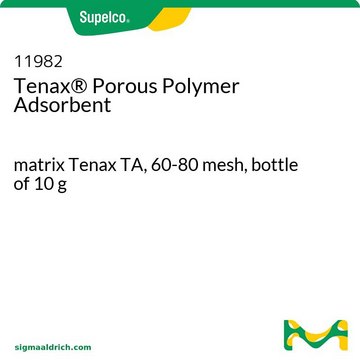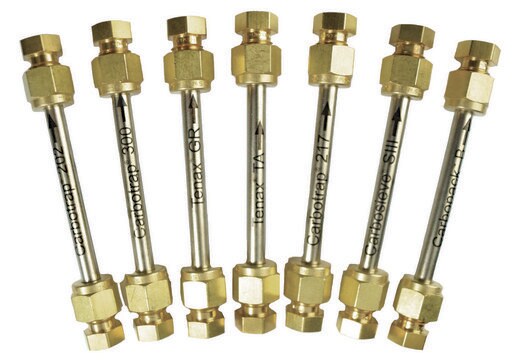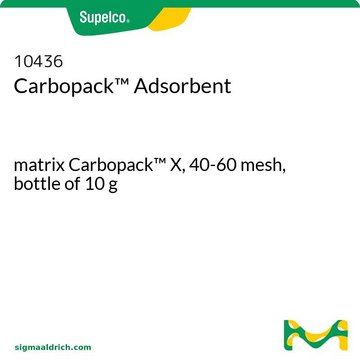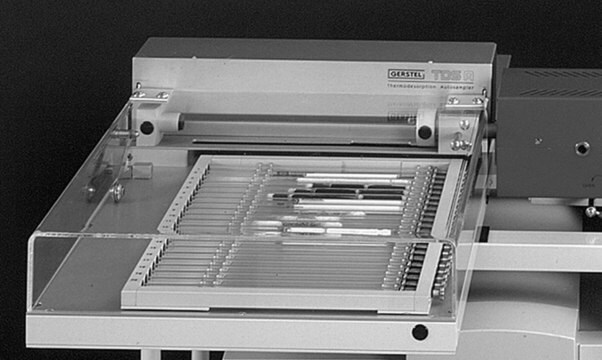20287
Carbotrap® Adsorbent
matrix Carbotrap® B, 20-40 mesh, bottle of 10 g
Sign Into View Organizational & Contract Pricing
All Photos(1)
About This Item
EC Number:
UNSPSC Code:
23201100
Recommended Products
product line
Carbotrap®
form
granular
packaging
bottle of 10 g
technique(s)
LPLC: suitable
surface area
~100 m2/g
matrix
Carbotrap® B
matrix active group
carbon
particle size
20-40 mesh
pore size
0 Å pore diameter
~0 cm3/g macroporosity
~0 cm3/g mesoporosity
~0 cm3/g microporosity
density
~0.38 g/mL (free fall density)
separation technique
reversed phase
General description
A graphitized carbon black (GCB) can be non-porous or porous. The graphitization process results in a highly pure surface with great adsorption and desorption (if required) properties. Surface interactions depend solely on dispersion (London) forces. These particles are:
Generally, GCB adsorbents offer weaker relative adsorptive strength compared to carbon molecular sieve (CMS) adsorbents, and similar relative adsorptive strength compared to spherical graphitized polymer carbon (SGPC) adsorbents. Our Carbotrap products are a type of GCB adsorbent.
For more information about any of our specialty carbon adsorbents, please visit sigma-aldrich.com/carbon
- Granular
- Friable
- Used for molecules with an analyte size relative to C3-C20+ n-alkanes
- Hydrophobic (can be used in high humidity environments)
Generally, GCB adsorbents offer weaker relative adsorptive strength compared to carbon molecular sieve (CMS) adsorbents, and similar relative adsorptive strength compared to spherical graphitized polymer carbon (SGPC) adsorbents. Our Carbotrap products are a type of GCB adsorbent.
- Particles are 20/40 mesh
- These large particles allow high flow rates without excessive pressure drops
For more information about any of our specialty carbon adsorbents, please visit sigma-aldrich.com/carbon
Legal Information
Carbotrap is a registered trademark of Merck KGaA, Darmstadt, Germany
Storage Class Code
11 - Combustible Solids
WGK
nwg
Flash Point(F)
Not applicable
Flash Point(C)
Not applicable
Personal Protective Equipment
dust mask type N95 (US), Eyeshields, Gloves
Choose from one of the most recent versions:
Certificates of Analysis (COA)
Lot/Batch Number
Don't see the Right Version?
If you require a particular version, you can look up a specific certificate by the Lot or Batch number.
Already Own This Product?
Find documentation for the products that you have recently purchased in the Document Library.
Customers Also Viewed
Plant Volatile Analysis.
Linskens HF and Jackson JF.
Modern Methods of Plant Analysis, 19, 54-56 (1997)
Florian Gahleitner et al.
Bioanalysis, 5(18), 2239-2247 (2013-09-24)
In-community non-invasive identification of asthma-specific volatile organic compounds (VOCs) in exhaled breath presents opportunities to characterize phenotypes, and monitor disease state and therapies. The feasibility of breath sampling with children and the preliminary identification of childhood asthma markers were studied.
Yifei Sun et al.
Journal of environmental sciences (China), 25(1), 213-219 (2013-04-17)
A group parameter approach using "total organic halogen" is effective for monitoring gaseous organic halogen compounds, including fluorine, chlorine, and bromine compounds, generated from combustion. We described the use of barrier-discharge radiofrequency-helium-plasma/atomic emission spectrometry, for the detection of semi- and
S Ghittori et al.
Journal of toxicology and environmental health, 38(3), 233-243 (1993-03-01)
Benzene concentrations in urine samples (Cu, ng/L) from 110 workers exposed to benzene in chemical plants and gasoline pumps were determined by injecting urine supernate into a gas chromatograph. The urine was saturated with anhydrous N2SO4 to facilitate the passage
W A McClenny et al.
Journal of chromatography. A, 813(1), 101-111 (1998-08-11)
An evaluation of performance criteria for US Environmental Protection Agency Compendium Method TO-17 for monitoring volatile organic compounds (VOCs) in air has been accomplished. The method is a solid adsorbent-based sampling and analytical procedure including performance criteria for four merit
Our team of scientists has experience in all areas of research including Life Science, Material Science, Chemical Synthesis, Chromatography, Analytical and many others.
Contact Technical Service





